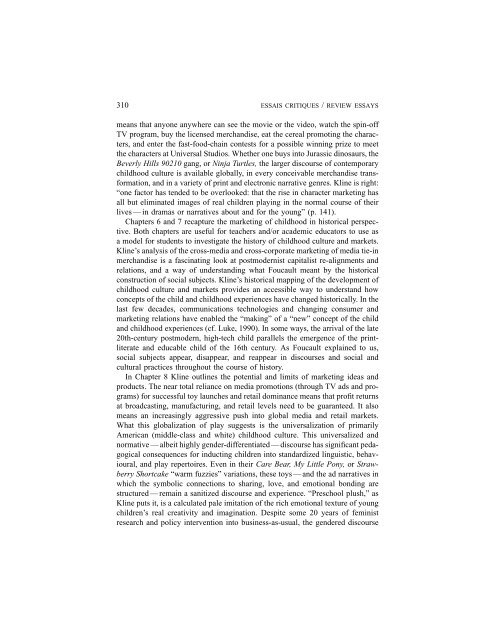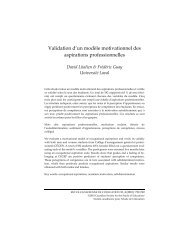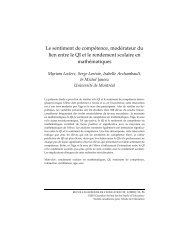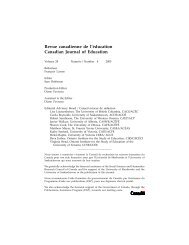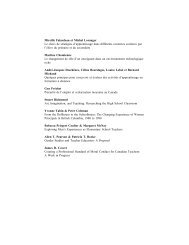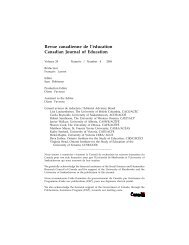Essai Critiques / Review Essays Out of the Garden and Into the Mall
Essai Critiques / Review Essays Out of the Garden and Into the Mall
Essai Critiques / Review Essays Out of the Garden and Into the Mall
Create successful ePaper yourself
Turn your PDF publications into a flip-book with our unique Google optimized e-Paper software.
310 ESSAIS CRITIQUES / REVIEW ESSAYS<br />
means that anyone anywhere can see <strong>the</strong> movie or <strong>the</strong> video, watch <strong>the</strong> spin-<strong>of</strong>f<br />
TV program, buy <strong>the</strong> licensed merch<strong>and</strong>ise, eat <strong>the</strong> cereal promoting <strong>the</strong> characters,<br />
<strong>and</strong> enter <strong>the</strong> fast-food-chain contests for a possible winning prize to meet<br />
<strong>the</strong> characters at Universal Studios. Whe<strong>the</strong>r one buys into Jurassic dinosaurs, <strong>the</strong><br />
Beverly Hills 90210 gang, or Ninja Turtles, <strong>the</strong> larger discourse <strong>of</strong> contemporary<br />
childhood culture is available globally, in every conceivable merch<strong>and</strong>ise transformation,<br />
<strong>and</strong> in a variety <strong>of</strong> print <strong>and</strong> electronic narrative genres. Kline is right:<br />
“one factor has tended to be overlooked: that <strong>the</strong> rise in character marketing has<br />
all but eliminated images <strong>of</strong> real children playing in <strong>the</strong> normal course <strong>of</strong> <strong>the</strong>ir<br />
lives — in dramas or narratives about <strong>and</strong> for <strong>the</strong> young” (p. 141).<br />
Chapters 6 <strong>and</strong> 7 recapture <strong>the</strong> marketing <strong>of</strong> childhood in historical perspective.<br />
Both chapters are useful for teachers <strong>and</strong>/or academic educators to use as<br />
a model for students to investigate <strong>the</strong> history <strong>of</strong> childhood culture <strong>and</strong> markets.<br />
Kline’s analysis <strong>of</strong> <strong>the</strong> cross-media <strong>and</strong> cross-corporate marketing <strong>of</strong> media tie-in<br />
merch<strong>and</strong>ise is a fascinating look at postmodernist capitalist re-alignments <strong>and</strong><br />
relations, <strong>and</strong> a way <strong>of</strong> underst<strong>and</strong>ing what Foucault meant by <strong>the</strong> historical<br />
construction <strong>of</strong> social subjects. Kline’s historical mapping <strong>of</strong> <strong>the</strong> development <strong>of</strong><br />
childhood culture <strong>and</strong> markets provides an accessible way to underst<strong>and</strong> how<br />
concepts <strong>of</strong> <strong>the</strong> child <strong>and</strong> childhood experiences have changed historically. In <strong>the</strong><br />
last few decades, communications technologies <strong>and</strong> changing consumer <strong>and</strong><br />
marketing relations have enabled <strong>the</strong> “making” <strong>of</strong> a “new” concept <strong>of</strong> <strong>the</strong> child<br />
<strong>and</strong> childhood experiences (cf. Luke, 1990). In some ways, <strong>the</strong> arrival <strong>of</strong> <strong>the</strong> late<br />
20th-century postmodern, high-tech child parallels <strong>the</strong> emergence <strong>of</strong> <strong>the</strong> printliterate<br />
<strong>and</strong> educable child <strong>of</strong> <strong>the</strong> 16th century. As Foucault explained to us,<br />
social subjects appear, disappear, <strong>and</strong> reappear in discourses <strong>and</strong> social <strong>and</strong><br />
cultural practices throughout <strong>the</strong> course <strong>of</strong> history.<br />
In Chapter 8 Kline outlines <strong>the</strong> potential <strong>and</strong> limits <strong>of</strong> marketing ideas <strong>and</strong><br />
products. The near total reliance on media promotions (through TV ads <strong>and</strong> programs)<br />
for successful toy launches <strong>and</strong> retail dominance means that pr<strong>of</strong>it returns<br />
at broadcasting, manufacturing, <strong>and</strong> retail levels need to be guaranteed. It also<br />
means an increasingly aggressive push into global media <strong>and</strong> retail markets.<br />
What this globalization <strong>of</strong> play suggests is <strong>the</strong> universalization <strong>of</strong> primarily<br />
American (middle-class <strong>and</strong> white) childhood culture. This universalized <strong>and</strong><br />
normative — albeit highly gender-differentiated — discourse has significant pedagogical<br />
consequences for inducting children into st<strong>and</strong>ardized linguistic, behavioural,<br />
<strong>and</strong> play repertoires. Even in <strong>the</strong>ir Care Bear, My Little Pony, or Strawberry<br />
Shortcake “warm fuzzies” variations, <strong>the</strong>se toys — <strong>and</strong> <strong>the</strong> ad narratives in<br />
which <strong>the</strong> symbolic connections to sharing, love, <strong>and</strong> emotional bonding are<br />
structured — remain a sanitized discourse <strong>and</strong> experience. “Preschool plush,” as<br />
Kline puts it, is a calculated pale imitation <strong>of</strong> <strong>the</strong> rich emotional texture <strong>of</strong> young<br />
children’s real creativity <strong>and</strong> imagination. Despite some 20 years <strong>of</strong> feminist<br />
research <strong>and</strong> policy intervention into business-as-usual, <strong>the</strong> gendered discourse


